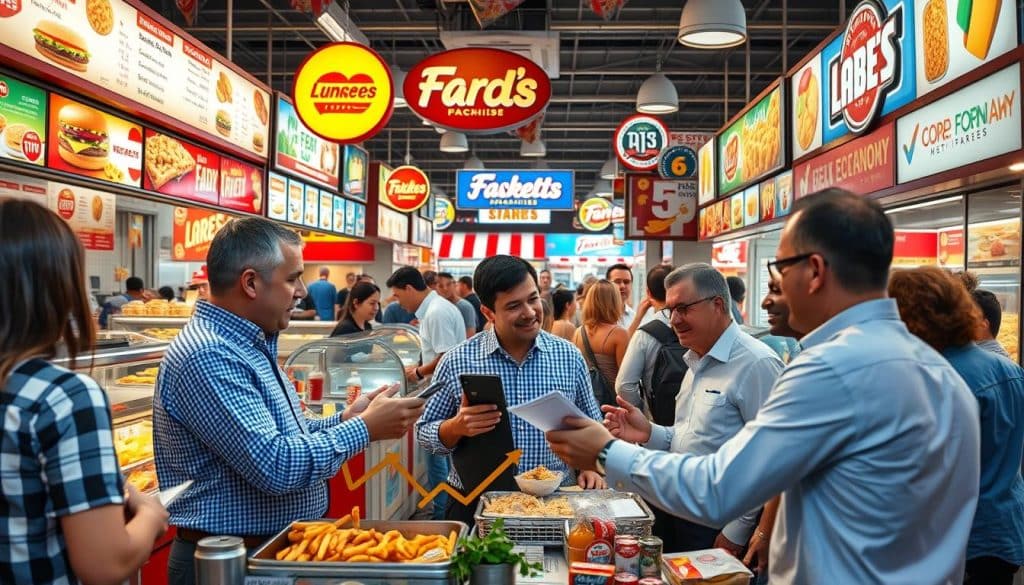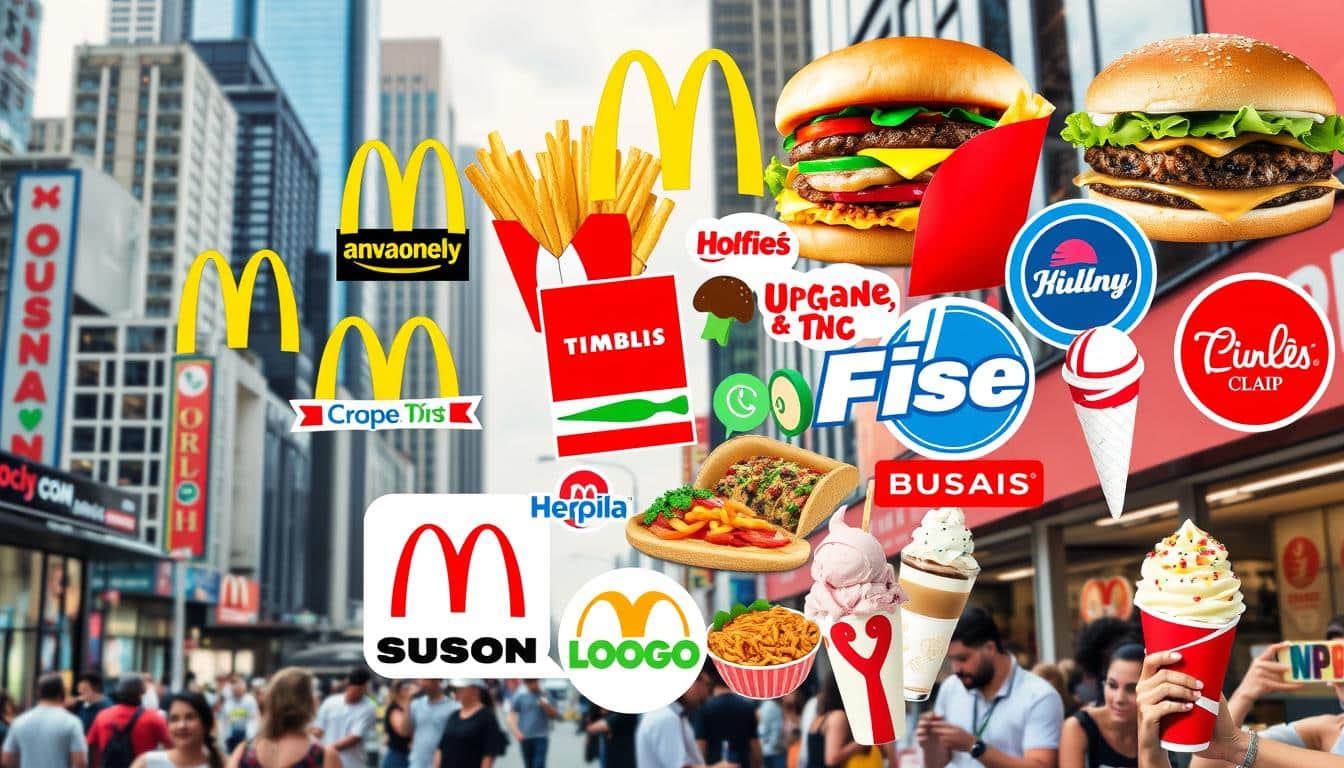What if you could easily join the world of food franchises? The U.S. market is full of chances, making it a key place for top food franchises. These businesses not only do well but also keep up with what people want. In 2023, chain restaurants made $227.6 billion, but which ones are the most profitable? And how do you pick the right one to invest in? This article will show you the secrets of the best food franchises, including what makes them special, how much you need to invest, and why they stand out.
As we explore the different types of food franchises, you’ll learn key things for success in this field. Knowing these details is important for anyone wanting to invest in America’s rewarding food industry.
Key Takeaways
- The U.S. food franchise market is growing, with revenues projected to increase from 2024 to 2029.
- Initial investment costs for top food franchises vary significantly, ranging from $150,000 to over $2 million.
- Franchising offers a structured business model with less risk, which is great for the food industry.
- Understanding the royalty fees for different franchises is key to making money.
- People want healthy and varied food options, shaping the future of food franchises.
- Technology is important for adapting and succeeding in food franchises today.
- Competition between big chains and independent restaurants is getting fiercer.
Overview of Food Franchises in the US
The US food franchise scene is full of chances for new and seasoned entrepreneurs. It’s a key part of the food industry, letting people use well-known brands and tested business plans. Knowing what makes a good franchise is key to success in this booming field.
Definition and Characteristics of Food Franchises
Food franchises let people run their own food shops with a well-known brand. They offer lots of help, like marketing and training, to help them do well. Brands like McDonald’s and Chick-Fil-A give their franchisees lots of support and a loyal customer base.
Franchisees save on marketing because the brand already has customers. This means they can make more money.
Importance of Franchising in the Food Industry
Franchising is very important for the food industry. It helps brands like Taco Bell and Jimmy John’s grow fast. It lets them open shops all over the country quickly.
It also helps entrepreneurs by giving them a proven business plan. This makes running a business easier in different places. Plus, it lets new products like those from Crumbl Cookies get out to more people, boosting sales.
Popular Categories of Food Franchises
Food franchises come in many types, each meeting different needs and tastes. Knowing these categories helps investors find the right fit in the food industry. The main types are fast food, casual dining, and coffee franchises, each with its own strengths.
Fast Food Franchises
Fast food franchises are everywhere, loved for their quick service and low prices. They’re perfect for people who are always on the move. Brands like McDonald’s, Subway, and Taco Bell are big names in this field, with menus that please many.
The cost to start a fast food franchise varies a lot. Subway starts at $100,000, while Taco Bell can cost between $530,000 to $3 million. These businesses make a lot of money and help the economy, with over $276 billion in sales.
Casual Dining Franchises
Casual dining franchises offer a relaxed dining experience. They have a wide range of menu options and a cozy atmosphere. Denny’s and Pizza Hut are well-known in this category, aiming to please with their diverse menus.
Starting a casual dining franchise can be more expensive. Costs range from Denny’s $1.4 million to $2.3 million. These places often have higher sales because of their inviting atmosphere.
Coffee and Beverage Franchises
Coffee franchises are growing fast, becoming a big part of our daily lives. They’re not just for coffee; they’re places to meet and work. Dunkin’ is a big name here, with costs between $526,900 and $1,809,500.
These franchises do well because people always want their coffee. They’re popular in busy cities where people are always on the move. With more people wanting delivery, coffee shops are finding new ways to reach customers.
Key Players in the Fast Food Franchise Sector
The fast food franchise sector is filled with key players. They lead the market with new ideas and smart marketing. These leaders have grown by listening to what customers want and focusing on quality.
McDonald’s: A Leader in Global Fast Food
McDonald’s is a big name in fast food, with about 41,822 locations worldwide. They sell 75 hamburgers every second and 13 billion French fries each year. With $25.757 billion in revenue as of June 30, 2024, McDonald’s shows it’s a strong business.
Its high sales per unit make it a top food franchise globally. But, opening a McDonald’s franchise can be expensive.
Subway: Customizable Choices and Fresh Ingredients
Subway is known for its wide range of customizable sandwiches and salads. They have over 39,000 outlets in more than 100 countries. Subway made $16.1 billion in 2023, thanks to its fresh ingredients and healthy options.
The low costs for starting a Subway franchise make it appealing to entrepreneurs. Subway’s focus on letting customers choose what they want helps it stay successful.
Taco Bell: A Unique Twist on Mexican-Inspired Food
Taco Bell is famous for its Mexican-inspired food. They have over 8,500 locations and made $13.2 billion in 2021. Taco Bell’s creative marketing and ability to change with trends attract many customers.
By always updating their menu and strong branding, Taco Bell stays a major player in the fast food world.
The Rise of Health-Conscious Food Franchises
The demand for healthy food is growing fast. People want meals that are full of nutrients and not too processed. This trend is great for health-conscious food franchises to grow in a changing market.
Studies show 79% of people want food made with clean ingredients. The pandemic made more people focus on eating healthy, with 20% eating more fresh food. Now, franchises that focus on health, sustainability, and being open are getting more popular.
Growing Demand for Healthy Options
More people are choosing healthier foods. A survey found 69% of consumers are willing to pay more for sustainable products. This shows successful health-focused franchises need to offer more healthy options.
Food delivery services have grown by 30% after the pandemic. This means people want easy, healthy meals. With over a third of consumers interested in nutrition apps, health-food businesses can use tech to keep customers coming back.
Notable Health-Focused Franchises
Many franchises are now focusing on health. They use organic ingredients, make food fresh, and are open about where they get their ingredients. This attracts a lot of loyal customers.
The health and wellness franchise industry is growing fast. Brands that offer a complete well-being experience are finding their niche. With more people ordering meals that fit their wellness goals, these franchises are doing well.
This shows health-conscious food franchises are here to stay. They’re not just a trend.
Expanding International Food Franchises
The world of international food franchises is changing fast. It offers global franchise opportunities for growth in the U.S. market. Brands are finding ways to connect with local tastes while keeping their unique charm. This approach helps them enter new markets and grow in the competitive U.S. scene.
Opportunities in Global Markets
More people in the U.S. are looking for different foods. This has opened doors for international brands. Jollibee plans to open 500 new locations in North America by 2030. Pret A Manger wants to grow from 58 to over 300 locations on the East Coast by 2029. These plans show the big chance for global brands to win over American customers.
Success Stories of International Brands in the US
Many international brands have found success in the U.S. Tim Hortons aims to reach 1,000 locations by 2028, starting with 630. El Pollo Loco has 475 locations, proving its popularity for chicken. Beard Papa’s has opened five new U.S. locations, attracting customers with its unique treats. These stories show how well international brands can do in the U.S.
Brands like Nando’s and Tai Er are showing the variety and appeal of international food. Nando’s started in the U.S. in 2008 and has grown. This shows the chances for foreign brands to succeed. As they explore new markets, their growth looks promising in the fast-changing world of international food franchises.
To learn more about other exciting brands, check out exciting international food franchises to watch in 2025.
Factors to Consider When Investing in Food Franchises
Investing in food franchises needs careful thought. Prospective franchisees must do their homework to succeed. Knowing the costs upfront and ongoing fees is key to making a good choice.
Initial Investment Requirements
The franchise costs vary a lot. Some food franchises start at tens of thousands, while others cost millions. Brands with strong support often cost more but can lead to better success.
Most successful restaurants use established franchising models. This shows the value of picking a well-known brand.
Understanding Royalties and Fees
Every franchise deal has rules about royalties and fees. These costs can eat into profits. About 95% of deals require strict marketing and operating rules.
Franchisees must carefully review these financial parts. They should make sure they fit with their business goals and expected earnings.
Location and Market Analysis
Doing a deep market analysis for franchises is vital before choosing a location. About 67% of investors say market analysis is key. The area’s demographics, traffic, and competition matter a lot.
Choosing a location that fits the brand well is important. It helps build trust with customers and can increase earnings.

The Role of Technology in Food Franchising
Technology is changing food franchising in big ways. It’s making operations better and improving how we connect with customers. Franchisors must keep up with new tech to stay ahead.
Online Ordering and Delivery Services
Online ordering has changed how we order food. Customers want easy ordering and quick delivery. Now, brands use GPS to track orders, making service better and faster.
Voice-activated systems help handle lots of orders. They offer personalized service. Data helps brands understand what customers want, making their offerings better.
This automation lets staff focus on giving great service. It makes the customer experience better.
Digital Marketing Strategies
Digital marketing is key for franchises today. It helps reach new customers and keep existing ones loyal. Personalized ads, based on data, are very important.
Tools like HubSpot help manage these efforts. They make sure ads are right for the audience. Brands use e-commerce and social media to grow their reach.
Mobile tech and customer relationship systems improve engagement. They help track how well franchises are doing. This info helps them get even better.
Challenges Facing Food Franchises Today
Food franchises face many challenges today, like supply chain problems and tough competition. Global events have shown how weak supply chains can cause delays and higher costs. This affects their profits a lot. With over 200,000 quick-serve restaurants in the U.S., the impact is huge.

Supply Chain Issues
Supply chain problems lead to higher costs for raw materials and less product. This makes it hard for franchisees to keep their menus the same. They need to find ways to overcome these issues.
By using local suppliers or finding different sources, they can lessen these problems. For more tips, check out this guide on dealing with these issues in the restaurant world.
Competition with Independent Restaurants
Franchises also compete with independent restaurants that can quickly change to meet local tastes. These independent places often offer unique things that draw customers away. To stand out, franchises need to make their brand more appealing and innovate their menus.
Keeping quality and service the same everywhere is also key. This helps franchises shine in a crowded market.
Starting a food franchise can cost between $116,000 and $3.7 million. So, it’s important for those starting to understand these challenges. By solving supply chain problems and being different from independent places, franchises can stay ahead.
Future Trends in the Food Franchise Industry
The food franchise industry is changing fast. It’s moving towards being more sustainable and eco-friendly. This change is because more people care about the environment. Franchises are now using ingredients wisely, cutting down on waste, and working in a greener way.
This shift not only meets what customers want but also makes them more loyal. For example, 43 percent of people are willing to pay more for food places that care about the planet.
Sustainability and Eco-Friendly Practices
For franchises to succeed in the long run, they need to focus on sustainability. They’re cutting down on plastic, using green energy, and adding more plant-based foods. These steps are not just good for the planet but also make customers happy.
By doing this, franchises are not only meeting today’s needs but also setting the bar high for tomorrow. This approach has already paid off, with a 5% increase in sales to $850 billion. It shows that going green can be good for business.
Innovations in Menu Offerings and Consumer Preferences
Franchises are also updating their menus to match what people want. They’re adding more ethnic flavors, plant-based options, and healthier choices. Technology, like AI and digital ordering, is helping make these changes.
By embracing these trends, franchises can stay ahead in a competitive market. They’re able to meet the changing tastes of their customers. This way, they can keep growing and succeed in the future.





